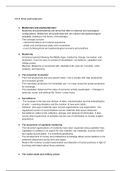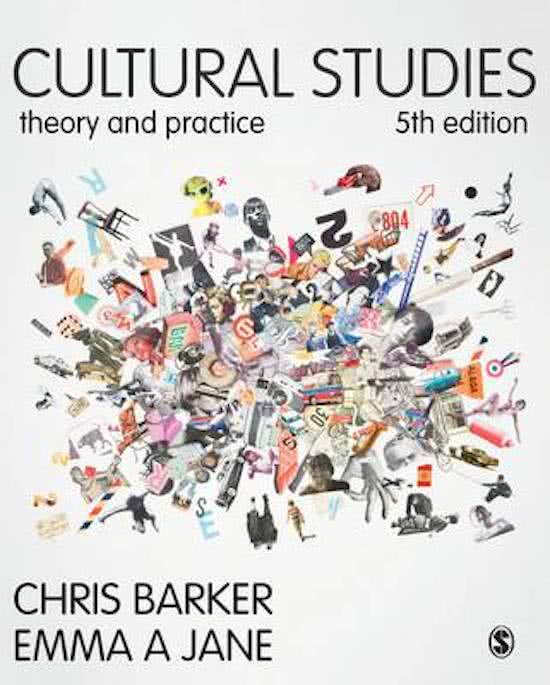CH 6: Enter postmodernism
● Modernism and postmodernism:
- Modernity and postmodernity are terms that refer to historical and sociological
configurations. Modernism and postmodernism are cultural and epistemological
concepts. (relating to the theory of knowledge)
- The concepts concern:
- cultural formations and cultural experience.
- artistic and architectural styles and movements.
- a set of philosophical and epistemological concerns and positions.
● Modernity:
A historical period following the Middle Ages, marked by change, innovation, and
dynamism. It can be seen to consist of industrialism, surveillance, capitalism and
military power.
Bauman: Modernity is concerned with; absolute truth, pure art, humanity, order,
certainty, and harmony.
● The industrial revolution:
- From low productivity and zero growth rates > into a society with high productivity
and increased growth.
- From domestic production for immediate use > to mass consumer goods production
for exchange.
- The population tripled and the value of economic activity quadrupled. > Changes in
personal, social, and political life. Rural > urban living.
● Surveillance:
- The increase in the size and division of labor, mechanization and the intensification
of work. > exerting discipline and the creation of new work habits.
- Giddens; ‘who says modernity says not just organizations, but organization - the
regularized control of social relations across indefinite time-space distances’
- Surveillance; refers to the collection, storage, and retrieval of information. It also
covers direct supervision of activities and the use of information to monitor subject
populations.
● The dynamism of capitalist modernity:
- The industrial organizations of modernity have been organized along capitalist lines.
- Capitalism is restless in its search for new markets, raw materials, sources of profit
and capital accumulation. It is inherently globalizing.
- The development of money and professional knowledge allows social relations to be
stretched (distanced) across time and space.
- Modern life involves constant examination and alteration of social practices in light of
incoming information about those practices.
● The nation-state and military power:
, - The modern nation-state: a container of power constituted by a political apparatus
recognized to have sovereign rights within the borders of a marked off territorial area.
It has the ability to back these claims with military power.
- Nations: not just political formations, They are also systems of cultural representation
by which national identity is continually reproduced through discursive action.
National identity is a form of imaginative identification with the nation-state.
- The state specializes in the maintenance of order through the rule of law.
● Modernism and culture:
The processes by which industrialism, capitalism, surveillance, and the nation-state
emerged we may call ‘modernization’. ‘Modernism’ refers to the human cultural forms
bound up with modernization.
● Modernism as a cultural experience:
Cultural modernism is an experience in which ‘All that is solid melts into air’. Industry,
technology and communications systems transformed the human world. Such
transformations hold out the promise of an end to material scarcity.
● Risk, doubt and reflexivity:
- Modern institutions are based on the principle of doubt. All knowledge is formed as a
hypothesis that is open to revision.
- Risk calculations play a central part in the strategic thinking of both institutions and
the lives of ordinary people.
- The markers of cultural modernism are ambiguity, doubt, risk, and continual change.
- Faust: can be regarded as the literary archetype of the dilemma of modern
development, that is, the interplay of creation and destruction.
● The flaneur:
- A flaneur; walks the anonymous spaces of the modern city experiencing the
complexity, disturbances, and confusion of the streets with their shops, displays,
images, and a variety of persons. This perspective emphasizes the urban character
of modernism.
- Detached from society with no other purpose than to be an acute observer of society.
● The dark side of modernity:
- Just as Faust was a troubled, destructive and tragic figure, so modernity is marked by the
poverty of industrial cities, wars, death camps and the threat of global annihilation.
- Modernism as a ‘structure of feeling’ involves pace, change, ambiguity, risk, doubt and
the chronic revision of knowledge. These are underpinned by the social and cultural
processes of Individualization, differentiation, commodification, urbanization,
rationalization, bureaucratization.
- Bureaucracy: is constituted by a framework of rule-governed and ordered activities that
continue irrespective of individuals and independent of their personal characteristics. It
stresses impersonality, the allocation of functions, rule systems and the processes of
documentation.
● Modernism as aesthetic style:
Modernism rejects the idea that it is possible to represent the ‘real’ in any straightforward






